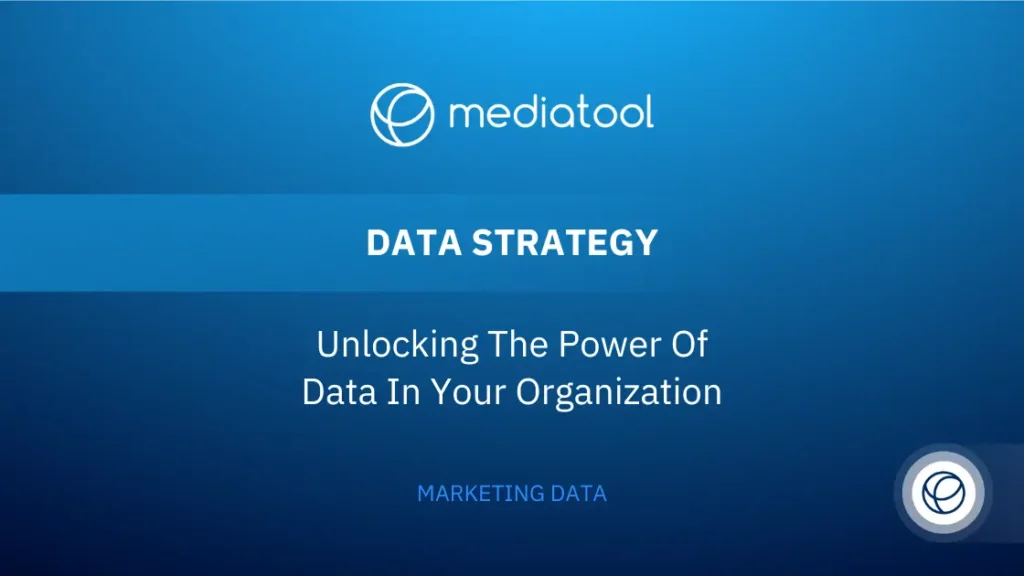Data strategy – it’s a term that’s thrown around a lot these days, but what does it really mean for your company?
You might feel like you’re drowning in data and it feels more like a relentless tide of confusion rather than a valuable asset.
Data is scattered across different systems, making it hard to understand or use effectively.
The result?
Missed opportunities, inefficient processes, and a growing sense of frustration.
But here’s the good news: it doesn’t have to be this way.
A well-planned data strategy can transform this chaos into clarity, making data a powerful tool that drives growth and innovation.
In this article, we’ll dive into what a data strategy is, why it’s essential, and how you can harness its full potential to propel your organization forward.
What is a Data Strategy?
A data strategy is a comprehensive plan outlining how an organization captures, manages, utilizes, and secures data. It’s an integral part of an enterprise’s overall business strategy, ensuring data management aligns with business objectives. This strategy encompasses various aspects of data handling, including data collection, storage, analysis, and sharing.
A data strategy is about turning raw data into a valuable resource that can drive informed decisions and business growth. It involves establishing clear policies and procedures for data governance to ensure data quality and integrity. This includes protecting data against breaches and maintaining data security throughout the organization.
Effective data management under a data strategy ensures that data is accessible and usable by different business units, promoting collaboration and eliminating data silos. By defining a clear roadmap for managing data operations, a data strategy provides a framework for leveraging data as a strategic asset.
A successful data strategy requires a focus on data literacy, empowering employees across the organization to understand and use data effectively. It’s about creating a culture where data is seen as a critical component of business success, driving everything from customer-focused business functions to internal decision-making processes.
Why is a Data Strategy Important?
A data strategy is vital to any organization aiming to harness the power of data effectively. It provides a comprehensive framework for managing and utilizing data, ensuring that it aligns with the business strategy and drives growth.
Let’s dive deeper into why a data strategy is so important.
Aligning Data with Business Objectives
A well-defined data strategy ensures that every aspect of data management aligns with the organization’s business objectives. It enables data analysts and business leaders to work towards common goals, using data as a tool to drive business decisions and strategies. Organizations can ensure that their efforts are focused and impactful by aligning data initiatives with business goals.
Breaking Down Data Silos
One of the key benefits of a data strategy is its ability to prevent data silos, which occur when data is isolated within different departments or business units. With an estimated typical company possessing over 2,000 distinct data silos, the issue of inaccessible information across the organization is significant.
A comprehensive data strategy promotes data integration and sharing across the organization, ensuring that data is accessible and valuable for all. This enhances collaboration and drives more informed decision-making, effectively tackling the challenge of isolated data repositories.
Supporting Informed Decision-Making
A successful data strategy enables organizations to analyze data effectively, turning raw data into valuable insights. This supports informed decision-making across the organization, from customer-focused business operations to strategic planning. By leveraging data analytics, businesses can uncover trends, identify opportunities, and make decisions backed by solid data.
Approximately 60% of organizations are leveraging data analytics to fuel business innovation, showcasing its significance in today’s competitive landscape. This approach not only enhances operational efficiency but also provides a significant competitive edge in the market.
What are the Advantages of Implementing a Data Strategy?

Implementing a data strategy offers numerous benefits to an organization, enhancing its ability to manage and use data effectively. Here are some key advantages:
Enhanced Data Quality
A successful data strategy strongly emphasizes data quality. By establishing rigorous data collection and management processes, organizations can ensure that the data they use is accurate, consistent, and reliable. This is crucial for data analysis and making informed decisions based on solid data. High-quality data is a strategic asset that forms the foundation for all data-driven initiatives.
Improved Data Governance
Data governance is at the heart of a robust data strategy. This involves setting clear data governance policies and procedures that guide how data is handled across the organization. Good governance ensures data integrity and consistency, which is essential for reliable data analysis and business intelligence. Furthermore, it plays a critical role in complying with data governance rules and regulations, safeguarding the organization against legal and reputational risks.
Forrester research indicates that only less than 10% of enterprises excel in using data insights for decision-making, with success largely depending on effective data governance practices rather than just technology or data alone.
Enhanced Data Security
A key component of a data strategy is ensuring data security. By defining and implementing stringent security measures, a data strategy protects sensitive information and reduces the risk of data breaches. This includes controlling data access and managing data storage securely. Data security is vital for maintaining customer trust and protecting the organization’s reputation.
Facilitation of Data Analysis and Analytics
Data strategy enables organizations to analyze data and leverage data analytics effectively. This involves using tools and techniques to extract meaningful insights from raw data, helping business leaders make strategic decisions. Organizations can align their data analysis efforts with their business objectives by providing a clear data strategy roadmap, driving growth and innovation.
Promotion of Data Literacy
A comprehensive data strategy also focuses on improving data literacy across the entire organization. It empowers employees in various business units to understand and use data effectively in their roles. This involves training and educating business users, data analysts, and other stakeholders on the importance of data and how to leverage it for business advantage. Increased data literacy leads to better data utilization and supports a data-driven culture.
However, while 82% of leaders expect basic data literacy from all employees and 79% claim to equip workers with necessary data skills, only 40% of employees confirm receiving such training, highlighting a gap in actual implementation.
Common Data Strategy Pain Points
While implementing a data strategy can bring significant benefits, organizations often encounter certain challenges or pain points along the way. Understanding these common issues is key to developing a more robust and effective data strategy.
Data Silos and Lack of Integration
A significant challenge in many organizations is the existence of data silos, where data is isolated within different business units or departments. This fragmentation hinders data access and analysis, particularly when data needs to span multiple business units. Overcoming these silos requires a data strategy that emphasizes data integration and a unified data infrastructure.
Maintaining Data Quality
Ensuring high data quality is a persistent issue. Poor-quality data, which may be inaccurate, incomplete, or outdated, can lead to flawed insights and misguided business decisions. A successful data strategy must include processes for consistent data management and controlled data transformations to maintain enterprise data integrity.
Data Security Concerns
Protecting sensitive information from unauthorized access and breaches is a critical concern. Data security challenges arise due to evolving threats and the complexity of safeguarding data across various platforms. An enterprise data strategy must include comprehensive data policies and technologies to secure the organization’s data effectively.
Compliance with Data Governance Policies
Adhering to data governance policies and regulations can be complex, especially for organizations that operate across different jurisdictions. A chief data officer often plays a key role in ensuring compliance and implementing data governance policies that align with legal requirements and industry standards.
Integrating with Existing Systems
Integrating a new data strategy with existing data architecture and technology infrastructure can also be a significant hurdle. Ensuring that the new strategy aligns with the company’s internal systems and data capabilities, and facilitates controlled data transformations, is essential for seamless operation.
7 Elements of Data Strategies

Developing a data strategy involves several key elements that contribute to its effectiveness. By focusing on these elements, organizations can create a data strategy that aligns with their goals and enhances their data and analytics capabilities.
1. Data Governance
Implementing a data governance policy is essential for effective data management. This involves establishing clear guidelines and rules for handling data and ensuring consistency and compliance across the organization. Effective governance is critical for managing business data, customer data, and other data types within the company.
2. Data Quality
Maintaining high data quality is vital for any good data strategy. This means ensuring that data is accurate, consistent, and reliable, whether it’s sales data, business data, or unstructured data. High-quality data is crucial for analyzing data and making informed decisions.
3. Data Architecture
A well-defined data architecture is a key component of a data strategy. The company’s data architecture describes the framework for storing, managing, and accessing data, including how data flows between systems and business units. A robust architecture supports efficient data technology and data warehouse operations.
4. Data Management
Effective enterprise data management encompasses all data collection, storage, and maintenance processes. This includes managing authoritative data sources and ensuring data is available and usable across the organization.
5. Data Analysis and Reporting
Utilizing data for analysis and reporting is a central aspect of data strategies. This involves applying data and analytics tools to extract insights from data, supporting business processes and operations. Analyzing data effectively is key to driving innovation and business success.
6. Data Security
Data security is critical, protecting data from unauthorized access and breaches. A robust data strategy ensures that sensitive information is safeguarded, utilizing data technology and practices that secure the organization’s data infrastructure.
7. Data Culture and Literacy
Promoting a culture of data literacy across the organization is vital. This involves educating employees about the value of data and encouraging its use in decision-making processes. A data-literate workforce is better equipped to leverage data for business advantage.
Organizations can develop a robust data strategy that drives business success and innovation by focusing on these elements.
Conclusion
Having a solid data strategy is essential for any organization that wants to keep up in today’s world, where data plays a significant role. This strategy is more than just managing data; it’s a key part of growing and changing for the better.
The way to a future where data is at the center involves always being ready to change and learn. Companies must update their data strategies regularly to stay up-to-date with new data trends and business needs. Bringing in new technologies and ideas will help you stay on top.
In short, a data strategy isn’t just a one-time plan. It’s an evolving guide that helps companies use their data in the best way possible. It turns data challenges into chances to get smarter and make better choices. As we look to the future, being good at managing and using data will be a big part of success.





